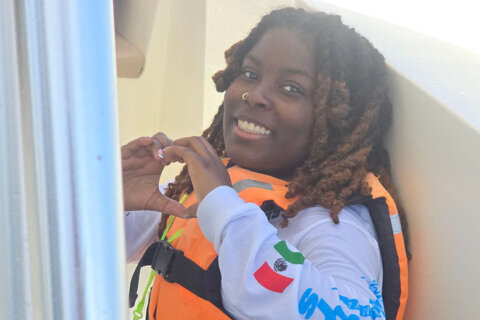This video is no longer available.
Richard Martin started donating whole blood with the Red Cross and then switched to Inova when he was asked to consider a different type of donation in 1982.
His father donated 17 gallons of whole blood, and Martin tried to reach that same achievement, but only made it to seven when he was asked about donating platelets, cell fragments in blood that form clots and stop bleeding, instead.
Martin considered it the major leagues of blood donations and was eager to start. At that time, the process involved donating from both arms.
He’s continued to donate platelets ever since, visiting Inova’s Blood Donor Service Center in Sterling, Virginia, every two weeks.
On Wednesday afternoon, squeezing a red, heart-shaped stress ball, Martin watched bags fill up and reflected on what would become his 700th donation.
“I’ll keep going until I die,” Martin said. “Or they say I can’t. That’s when I start crying.”
Martin is Inova’s highest active platelet donor, but he’s never met any of the people he’s helped. He received a large white cake and certificate to celebrate the achievement, but he said it isn’t something he’s thought much about.
Martin knows many of the employees at the donation center by name, and he hasn’t considered switching what he donates. He’s been poked and prodded so many times, he calls his right arm the Grand Canyon, and has a tattoo of it above the site where an IV would be inserted.
He’s planning to get the number 700 in Roman numerals etched on his other arm to honor the accomplishment.
Martin said he’ll never consider a double red cell donation, because there’s a “16-week vacation between donations. In 16 weeks, you can do nine platelet donations.”
Nicholas Lilly, senior director of Inova Blood Donor Services, said donating platelets takes about 70 minutes and can typically be done every two weeks. Staff also account for the predonation screening process, and the waiting period afterward.
“I’ll keep doing it until it doesn’t need to be done,” Martin said. “There’s all kinds of reasons, as far as doing it as often as I do. It’s called internal exercise. In other words, keeps the body moving, everything flowing.”
The platelets are used by cancer and leukemia patients, Martin said. An injured fireman could take 20 units of platelets to stabilize after burns, and on Wednesday, “I’m doing two units. Ten of me just to stabilize this person. There’s a lot of need for us.”
Martin was a donor recruiter for a decade, and there were a few times when there was a significant need for a critically ill patient. One patient had a platelet count in single digits, and Martin was asked to find about a dozen donors, so one could donate each day. He tracked down enough volunteers, confident from the outset they wouldn’t turn him down.
“It’s life saving,” Lilly said. “When we think about the need for blood products every day, there’s always hundreds of patients in our hospitals, truthfully, thousands in our hospitals that are in need. And so by having somebody, or donors like Rick who donate frequently, it really helps us to maintain the need.”
Martin, meanwhile, hopes to inspire other community members to give back.
“As far as the pinch, the mosquito bite, the bee sting, it’s only going to last five to 10 seconds, and then from then on, you’re good, you’re flowing,” Martin said.
Get breaking news and daily headlines delivered to your email inbox by signing up here.
© 2025 WTOP. All Rights Reserved. This website is not intended for users located within the European Economic Area.








